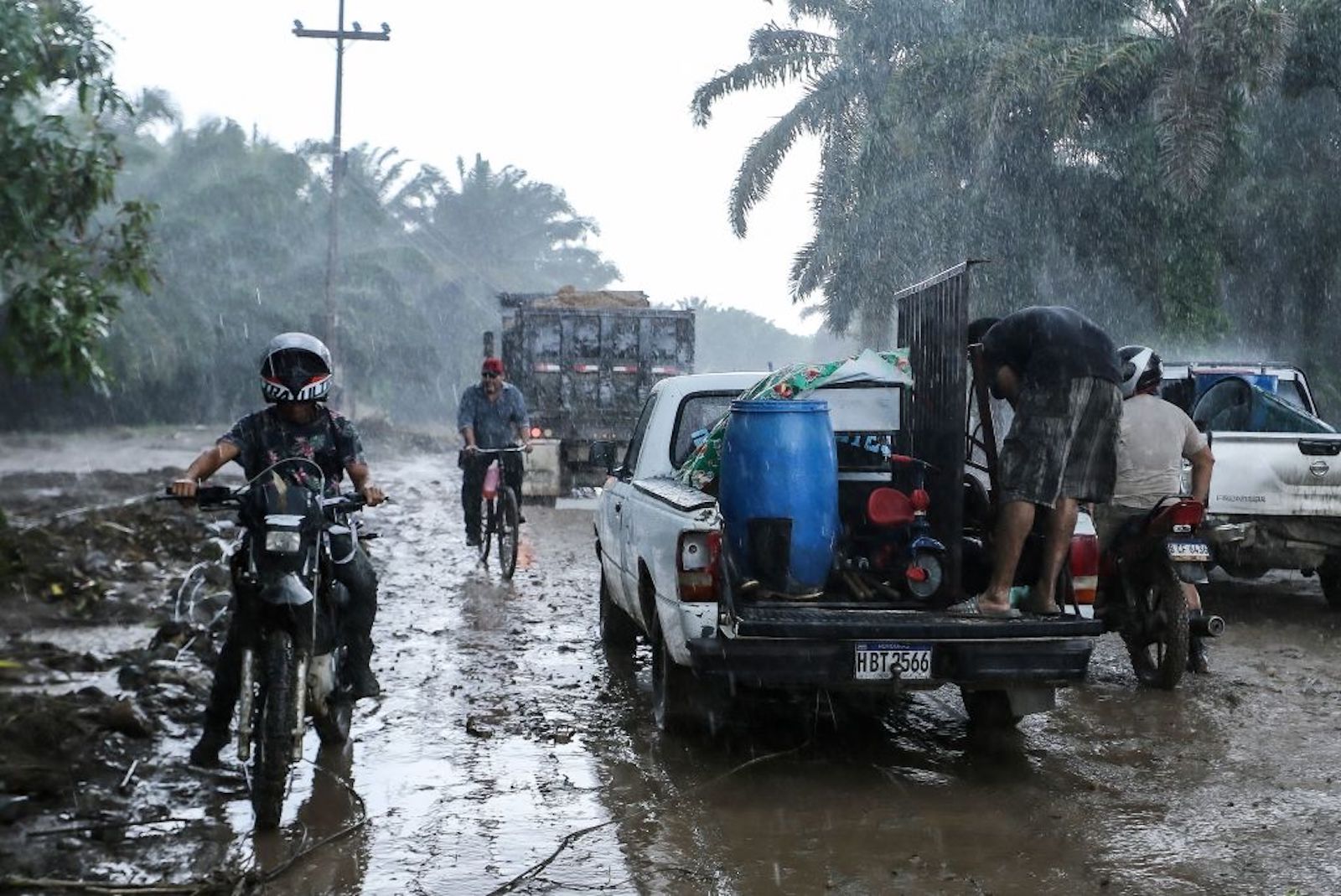? Follow the trajectory of storm Julia live
( Spanish) — Tropical Cyclone Julia has crossed the Caribbean, leaving in its wake heavy rains and floods in several countries in the region.
Julia formed off the La Guajira peninsula last Friday with hurricane watches and warnings issued for Nicaragua and several Colombian islands, the US National Hurricane Center (NHC) said at the time.
This Monday it is expected to move along the northwestern coasts of Nicaragua, Honduras, El Salvador and Guatemala, according to him NHC, for its acronym in English, which keep your warning of “risk of flash floods and landslides that threaten life in Central America and southern Mexico” until this Tuesday.
The agency warned of deadly floods and landslides in several parts of Central America this Monday and heavy rains in the Isthmus of Tehuantepec (a region between Oaxaca and Veracruz) in Mexico.
According to the most recent NHC update, Tropical Storm Julia is located over the extreme eastern Pacific Rim near the southern coast of Central America, moving at a speed of 25 km/h with maximum sustained winds of 65 km/h. .
Several dead leaves Julia in Honduras
Tropical storm Julia has a red alert in 10 of the 18 departments of Honduras, while the other eight are under a yellow alert.
Residents leave their houses in torrential rain in the old banana fields of the municipality of El Progreso, department of Yoro, Honduras, before the arrival of tropical storm Julia on October 8, 2022. (Credit: WENDELL ESCOTO/ AFP via Getty Images)
The authorities confirmed this Monday that at least three people have died after the passage of the cyclone. Two of them died in the departments of Gracias a Dios, in the northeast, and one in the Chamelecón River, in the west of the country, near the border with Guatemala, according to Armando Juárez Brito, Copeco’s Director of Preparedness and Response. According to the official, at least 9,200 people are in shelters and there are 1,137 shelters operating throughout the country.

Residents leave their house in the old banana fields of the municipality of El Progreso, Yoro department, Honduras, before the arrival of Tropical Storm Julia on October 8, 2022. (Credit: WENDELL ESCOTO/AFP via Getty Images )
The Chamelecón River, in La Lima, Honduras, increased its flow considerably due to the rains left by the passage of Julia. And according to the Secretariat of National Risk and Contingency Management Offices, Copeco, the flow could grow much more, generating strong floods in the lower part where many homes are already flooded.

Residents in the municipality of La Lima, department of Cortés, Honduras, look at the Chamelecón river that threatens to overflow due to the rains left by tropical storm Julia on October 9, 2022. (Credit: WENDELL ESCOTO/AFP via Getty Images)
Since last Friday, the Honduran government has prepared more than 1,200 shelters nationwide to “face the climate emergency” that the arrival of tropical storm Julia would entail.
Red alert in El Salvador
The authorities of El Salvador declared a red alert before the arrival of tropical storm Julia and its possible effects starting this Sunday night, according to the forecasts of the Ministry of the Environment.
Early this Monday the center of Tropical Storm Julia it was 35 kilometers south of San Salvador. Environment Minister Fernando López reported that Julia’s cloud field “is over the entire country,” so “intense rains accompanied by strong gusts of wind” are forecast.
“It’s going to be rainy, we’re going to have a lot of precipitation on Monday, Tuesday. Rainfall amounts above 100 millimeters are expected. That is to say, it will rain what usually rains in a couple of weeks, it will be concentrated in those two days, therefore, we have to be prepared,” warned Fernando López, Minister of the Environment of El Salvador at a press conference. .
Heavy rains are expected that could cause flooding, as well as landslides, falling trees and the overflow of rivers or streams throughout the territory.
The Legislative Assembly decreed a national emergency for 15 days, with the purpose of facilitating the use of resources by the government to deal with the emergencies caused by the passage of Julia.
The government has enabled some 61 temporary shelters in different areas to preventively transfer families living in places of risk or those that require it due to possible floods.
“Intense rains” in Guatemala
The National Coordinator for Disaster Reduction of Guatemala (CONRED) reported this Sunday that there are heavy rains over much of the country, mainly in the northern region and the Caribbean.

The passage of the storm caused the collapse of drains and affected homes in the urban area, Sayaxché, in the department of Petén, in northern Guatemala. (Credit: Conred/Twitter)
The Red Cross reported on its Twitter account that a river in Puerto Barrios overflowed, causing floods.

Floods in Santo Tomás de Castilla, in Puerto Barrios Izabal, Guatemala, after the passage of storm Julia on October 9, 2022. (Credit: CONRED, Guatemala)
Julia in Nicaragua
This Sunday, Hurricane Julia made landfall near Laguna De Perlas in Nicaragua at dawn, with category 1 winds of 140 km/h. At 6 pm local time, its center was over the Pacific about 220 kilometers southeast of the capital of El Salvador, according to the United States National Hurricane Center (NHC).
Around a million inhabitants of the coastal region of Nicaragua were left without electricity and internet due to the fall of the lines, as well as the government’s decision to cut electricity for security reasons, Vice President Rosario Murillo said, according to media. local.
“The incidents have been material and minor. We do not have any deceased person reported so far,” Murillo said.
These visits are part of the accompaniment and attention that is being given to the families, after the passage of Julia.#Nicaragua pic.twitter.com/1ntLXwkMYh
– The 19 Digital (@el19digital) October 10, 2022
The damages, according to the vice president of Nicaragua, have been mainly in the road network, in telecommunications, in the roofs of many houses and the heavy rains have generated landslides and floods, Murillo said.
Nicaragua’s National Disaster System said in a tweet on Sunday that the entire country was on “red alert” after heavy rains caused several rivers to flood.
Guillermo González, director of Nicaragua’s disaster system, told a press conference that Julia had not caused any fatalities in the country but that more than 13,000 families had been evacuated, more than 800 houses had been flooded and many roofs had been damaged. Reuters reported.
Slight damage in Colombia after the passage of Julia
Julia’s passage through Colombia affected the island of San Andrés and as reported on his Twitter account this Sunday by Javier Pava, general director of the National Unit for Disaster Risk Management (UNGRD), the damage was slight: two people injured, 2 houses destroyed, 101 damaged, as well as falling trees in the area. The alert on the island remains as Julia’s influence wears off, Pava said.

Fallen trees are seen after the passage of tropical storm Julia on the island of San Andrés, Colombia, on October 9, 2022. – Julia passed over a trio of Colombian islands, an Environment Ministry official told AFP, causing rain and lightning in the north of the country. (Credit: MICHAEL AREVALO/AFP).
In San Andrés, strong winds tore the tin roofs off houses, according to police captain Octavio Gutiérrez, quoted by Reuters. This Sunday, the streets echoed with the sound of hand saws that police and locals used to clear fallen tree trunks and branches.

Colombian President Gustavo Petro assessed the damage in San Andrés after Julia passed on October 9 and reported slight damage to infrastructure on the island. (Credit: Twitter / Gustavo Petro)
The Civil Defense of Colombia reported that it rescued 34 people who were trapped in a nursing home in San Andrés due to storm Julia.

Personnel from the Colombian Civil Defense rescued 34 people from a nursing home in San Andrés on October 9, 2022. (Credit: DefensaCivilCo/Twitter)










